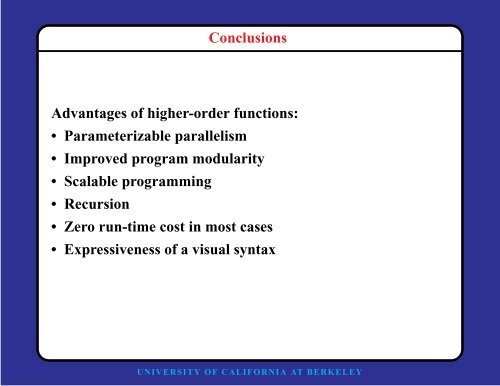Conclusions Advantages of higher-order functions ...
Conclusions Advantages of higher-order functions ...
Conclusions Advantages of higher-order functions ...
You also want an ePaper? Increase the reach of your titles
YUMPU automatically turns print PDFs into web optimized ePapers that Google loves.
<strong>Conclusions</strong><br />
<strong>Advantages</strong> <strong>of</strong> <strong>higher</strong>-<strong>order</strong> <strong>functions</strong>:<br />
• Parameterizable parallelism<br />
• Improved program modularity<br />
• Scalable programming<br />
• Recursion<br />
• Zero run-time cost in most cases<br />
• Expressiveness <strong>of</strong> a visual syntax<br />
UNIVERSITY OF CALIFORNIA AT BERKELEY
In SDF, recursion is statically unrolled<br />
In our example, a high-<strong>order</strong><br />
FFT is constructed from lower<br />
<strong>order</strong> FFTs. So the granularity<br />
and degree <strong>of</strong> parallellism are<br />
parameterized.<br />
UNIVERSITY OF CALIFORNIA AT BERKELEY
Using Map for Recursion in Dynamic Dataflow<br />
The “sieve <strong>of</strong> Erastosthenes” is a highly irregular recursive algorithm for computing<br />
prime numbers. The DDF domain in Ptolemy can model algorithms <strong>of</strong> this type.<br />
UNIVERSITY OF CALIFORNIA AT BERKELEY
Using IfThenElse for Recursion<br />
Recursive FFT<br />
UNIVERSITY OF CALIFORNIA AT BERKELEY<br />
granularity <strong>of</strong> the bottomlevel<br />
operation is arbitrary<br />
recursion can be unraveled<br />
at compile time, avoiding<br />
any run-time overhead
Generalization <strong>of</strong> Map to Signal Sources<br />
The ParSourcesGr (now called<br />
SrcGr) is a Map star with no<br />
inputs. The number <strong>of</strong> instances<br />
is determined by the number <strong>of</strong><br />
outputs. The BusSplit is also an<br />
HOF star.<br />
UNIVERSITY OF CALIFORNIA AT BERKELEY
Higher-Order Functions in Ptolemy<br />
Examples implemented in Ptolemy:<br />
• Map (apply a specified function to all inputs)<br />
• MapGr (graphical version <strong>of</strong> Map)<br />
• IfThenElse (apply one <strong>of</strong> two specified <strong>functions</strong>)<br />
• Chain (apply a specified function sequentially)<br />
This example applies gains<br />
<strong>of</strong> 1, 2, and 3 to three successive<br />
ramp signals and<br />
displays the three results.<br />
UNIVERSITY OF CALIFORNIA AT BERKELEY
Key Idea in Visual Programming<br />
UNIVERSITY OF CALIFORNIA AT BERKELEY<br />
Syntactically<br />
separate<br />
stream and<br />
non-stream<br />
arguments.
Higher-Order Functions<br />
HOFs are <strong>functions</strong> that take <strong>functions</strong> as arguments and<br />
return <strong>functions</strong>. For example<br />
map f<br />
returns a function that applies function f to elements <strong>of</strong> a list.<br />
In a typical functional language (Haskell):<br />
scan (f, init, ⊥) = init<br />
scan (f, init, (x:xs)) = f (x,scan(f, init, xs))<br />
where ⊥ means no arguments. So,<br />
scan ((+), 0, list)<br />
adds all the elements <strong>of</strong> a list.<br />
UNIVERSITY OF CALIFORNIA AT BERKELEY
Higher-Order Functions<br />
Wan-Teh Chang<br />
Edward A. Lee<br />
Alan Kamas<br />
Thomas M. Parks<br />
UC Berkeley<br />
Karim P. Khiar<br />
Thomson SGS<br />
UNIVERSITY OF CALIFORNIA AT BERKELEY
















